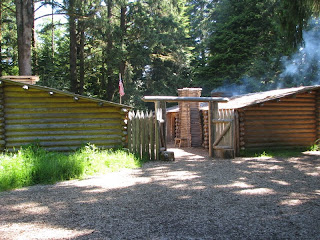September 19-22, 2013 – Mount St. Helens National Volcanic Monument, Silver Lake Area
Thursday morning was again overcast but it was
not raining as we left Seaview. We drove
west along the Columbia River to Longview and then turned north on I-5 to
Silver Lake. We are staying at Silver
Cove RV Resort, a very nice resort on Silver Lake. The sites here are large and are all gravel
but there is a lot of grass behind all the sites. The loops in this resort are laid out along
small canals. We are backed into a site
that has a very large grassy area with trees between us and a canal. It is a lot better view than the back of
another 5th wheel a few feet away like we had at the last
resort. It was nice a sunny and warm
when we arrived but the ladies in the office told us to enjoy the sun as it is
suppose to rain for the next several days.
After we got set up and ate a late lunch we drove to the
Mount St. Helens Visitor Center operated by the Washington State Parks. We watched a short film and walked through
the displays about volcanoes and the Mount St. Helens eruption in 1980. The huge landslide at the beginning of the
eruption caused a massive mudflow down the North Fork of the Toutle River. This mudflow buried the valley above where we
are staying.
Friday morning we decided to get an early start and head to
Mount St. Helens National Volcanic Monument while the weather was still good. We stopped at an overlook along the way and
got our first really good look at the mountain.
We stopped at a couple of displays telling about how the forest is
regenerating about being destroyed. Once
we got inside the national monument, on one side of the road is a tree farm run
by Weyerhaeuser and has been replanted and the opposite side is in the monument
and is being left to regenerate naturally.
The replanted side was a lot more heavily wooded than the natural side
but we were still amazed at how much the forest has regenerated in the 33 years
since the eruption.
We
drove to the end of the highway that had to be totally rebuilt after the
mudflow completely covered the original road to the Johnston Ridge
Observatory. This observatory is now the
official visitor center for the west side of the monument. We watched two very good short films – one on
the geology of the eruption and the other one on the regeneration of the
forest. At the end of each film the
screen rolled up into the ceiling and the curtains opened giving us a wonderful
view of the crater and lava dome through a wall of windows. We could even see steam coming out of the
crater - it was great!
The displays in this visitor center were very good because
they not only told the story of the eruption they also told personal
stories. There was one wall dedicated to
stories about people who survived the eruption and some that did not. It was amazing to read what some of these
people endured to survive and get out of the blast area alive. The center also has a seismograph connected
to a mat on the floor. You jump on the
floor and can watch the seismograph record your impacts – we couldn’t get a
very large reading on the graph which is probably a good thing! Another display let you place your hands on
the surface and feel the vibrations a seismograph on Mount St. Helens feels. You could feel the vibrations of an elk
walking by, an earthquake on the other side of the world and many other things
that the seismograph can record.
We hiked the Eruption Trail which gave us great views of the
crater and the valley below. You could
see where the landslide and mudflow ran and the huge deposits they left in the
valley. We only hiked this trail for a
little more than a half mile as the wind was blowing hard.
When we finished at the visitor center we drove to the
Coldwater Lake Recreation Area where we had lunch in the picnic area and then
hiked along the Birth of a Lake Trail. Many new lakes were formed when debris
from the landslide and mudflow blocked creeks and rivers. Coldwater Lake was formed when waters backed
up behind a natural dam in Coldwater Creek.
This short trail along this beautiful lake had interpretative signs
telling how the lake was created and life returning to the area after the
eruption. When we finished this short
trail we hiked for a while on the Lakes Trail which follows the north shore of
Coldwater Lake for about 5 miles and then goes to a number of smaller lakes
about 4 to 5 miles to the northeast. We
followed the trail along the shore for a couple of miles and then turned back. We were amazed at how clear this lake is
because the signs said it was so foul when it was formed that it stank. The lake cleared up very quickly by natural
processes.
We really enjoyed visiting the northwest side of the
monument and are glad we made the trip today as the clouds are starting to
build and the forecast is for rain for the next few days.
It rained lightly off and on all day Saturday so we decided
it was a good day to go grocery shopping and do some reading.
Sunday it rained hard all day – another good day to stay
inside. We got the laundry done and more
reading and playing computer games. Now
we are really glad we went to Mount St. Helens National Monument on Friday.






.JPG)

Comments
Post a Comment